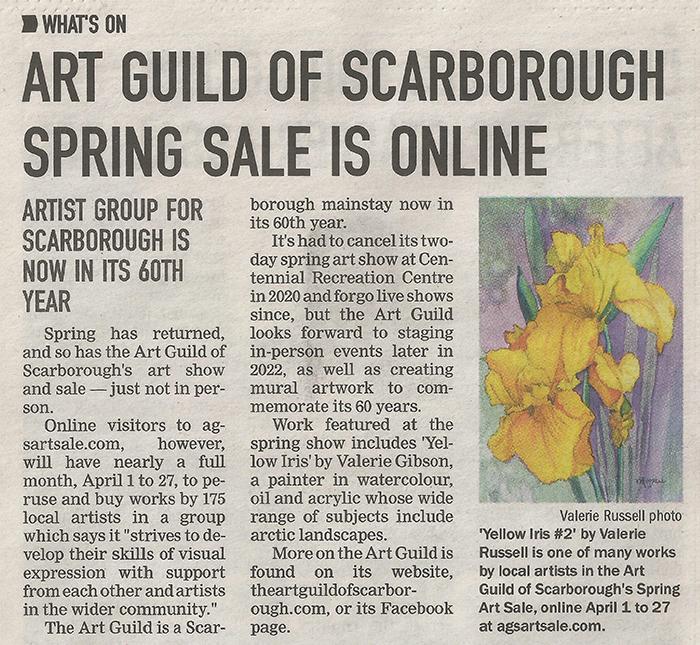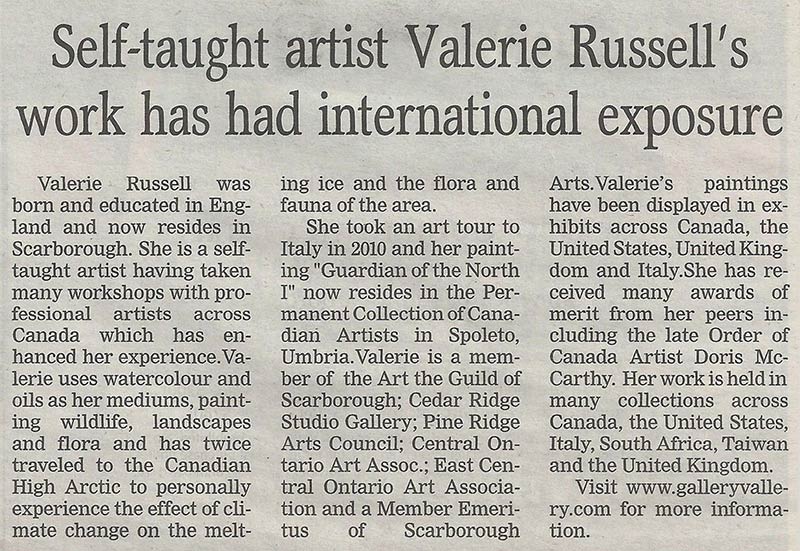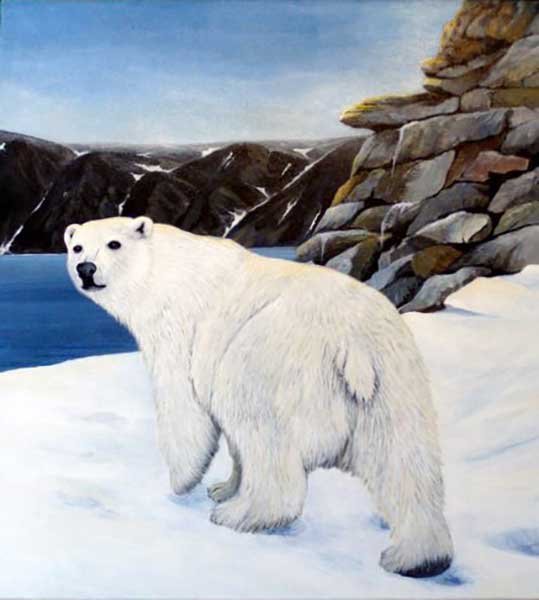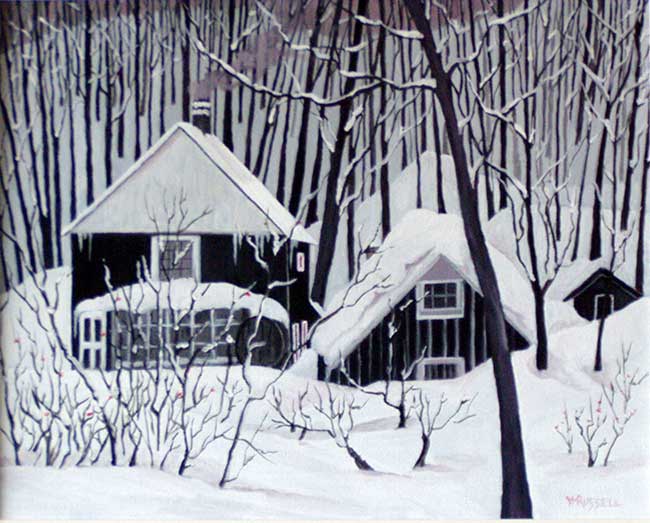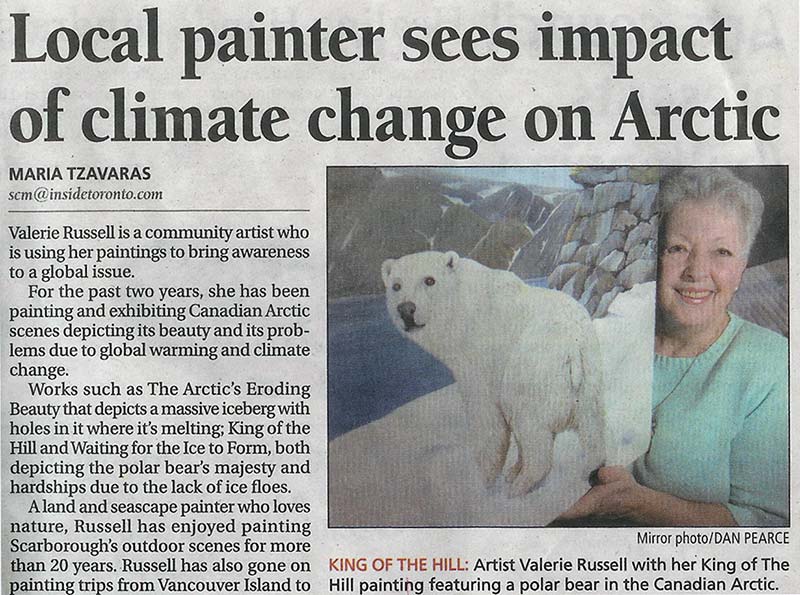News from The Scarborough Mirror
March 31, 2022
Russell is one of many artists in the Art Guild of Scarborough Spring Art Sale.
Val’s painting ‘Yellow Iris #2″ was featured on “WHAT”S ON”, page 13.
December 22, 2016
Self-taught artist Valerie Russell’s work has had international exposure
Val’s painting was featured on the front cover.
December 2016. Val’s painting, Follow Me has been chosen to be printed as a Greeting Card for the Charity Campaign.
TPH® Charitable Office only supports registered Canadian charities that spend their funds in Canada. Emphasis is placed on providing support to those communities in which we conduct business. Each year, the benefiting charity receives 100% of the net proceeds. To learn more, please visit: The Printing House
ORIGINAL PAINTING SOLD
Limited Editions of Giclee Reproductions Available.
December 2014. Val’s painting, Winter Hide-Away has been chosen to be printed as a Greeting Card for the Charity Campaign.
TPH® Charitable Office only supports registered Canadian charities that spend their funds in Canada. Emphasis is placed on providing support to those communities in which we conduct business. Each year, the benefiting charity receives 100% of the net proceeds.
March 14, 2007. Written by Maria Tzavaras, photo by Dan Pearce.
Excerpt: In 2005, Russell embarked on a journey to Nunavut after being inspired by legendary artist Doris McCarthy. “The moment you step off the plane in Iqaluit, it’s just so beautiful and views are amazing” she said. The awe and love for the Arctic turned into concern when Russell returned a year later, in July 2006, and things had visibly changed. In a year, you could absolutely see the difference and you can hear it from the Inuit as well.
The art of remembering snow
CLIMATE CHANGE | It’s jeopardizing more than southern farmlands and northern ice fields. By taking away our Canadian winter, it’s endangering our very identity, writes Leah Sandals. January 07, 2007
Oh yes, that’s it – we seem to be missing winter.
After the warmest December ever recorded, climate change seems to be well upon us. And along with losing farmland, tundra and endangered species, we may be losing something more nebulous but even more important: national self-image. “The Great White North,” the winter-scene paintings of the Group of Seven, the continuing (if false) self-identification with wilderness – climate change puts all of these things at risk too.
In response to the impending loss, artists from sea to (growing) sea are working on themes of climate change and what it means for us.
Other nations have actually been on the vanguard in this respect. U.K. artist David Buckland organized an Arctic artist tour and associated exhibition at London’s Natural History Museum last year. The climate change expedition and show grew out of the Cape Farewell project co-ordinated by Buckland (more information can be found at http://www.capefarewell.com). U.S. artist Jane Marsching launched a live Arctic audio feed at Boston Institute of Contemporary Art last month. And photographer Stuart Franklin (who snapped the iconic Tiananmen Square image) plans to publish a book of photographs on the topic in 2008.
An emerging figure in our melting cultural landscape is the “polar artist” who travels far north to record effects of climate change. Canada’s Polar Artists Group (PAG) is a recently formed nonprofit society “dedicated to promoting awareness of the polar regions … and effects of climate change on the environment and people through art, education, and special projects.” Members have taken several trips to the Far North already, and the group itself is planning more for the International Polar Year, which kicks off in March.
Scarborough’s Valerie Russell is a polar artist who has visited the north twice on expeditions. Though her paintings seem benign in content and style, Russell’s message is anything but. Take a painting of a polar bear on a picturesque arctic shoreline, innocuous but for its title: Waiting for the Ice to Form. Russell explains, “The sightings of polar bears waiting at the shoreline for the ice to form is now commonplace … there has been so much written regarding global warming and disastrous results will compound if no action is taken.”
Though the statistics Russell cites are bleak – for example, that it’s possible all ocean ice will be gone by 2080 – she gains hope by working with like-minded artists. “One person alone can do very little,” she says, “but with the Polar Artists project, its mandate being one of bringing together art, science and education, we will make more people aware of the impacts of global warming.”
Tania Kitchell and Germaine Koh apply much heralded artistic power of observation to minute climatic changes, acts that gently encourage others to do the same.
For five years, Kitchell would write down the date, time and temperature every few hours. Then, on the first day of different seasons, she would spend time recording very small changes in temperature, “watching the thermometer go from 5.5 degrees to 5.6 to 5.7 and down again in one hour.”
But Kitchell’s connection to winter isn’t just one of scientific quantification; she also creates poignant self-portraits of her interaction with frigid weather, including photographs of herself embracing massive snowballs, and pictures of her own foggy breath in cold night air.
Koh’s interactive works bring second-by-second climate observations inside the architectures designed to shield us from them. In Fair Weather Forces, an indoor turnstile is rigged to spin at the same speed as the wind outside, and the lights in a windowless room are synchronized to brighten or dim depending on the local cloud cover.
As with our broader weather problems, Koh’s “artifice” offers no real escape.
“A principle in my work is to pay attention to things we might not always take notice of, including incremental changes related to human behaviour,” Koh says. “It’s not polemical – more a gentle prodding to pay attention to stuff around us.”
“Snow power” is what inspires artists Hannah Jickling and Shannon Cochrane, who honour pristine snowfalls in their humorous, absurd performances.
Born and raised in the Yukon, Jickling has, for the past three years, been using the humble action of snow shovelling to make outdoor art with fellow Yukoner Valerie Salez.
Initially, Jickling and Salez started the work as a means of connecting to their homes in the Far North while living far away. As neighbours, they often saw each other shovelling snow, and started to play pranks on friends and public alike with unconventional pilings and patternings. “We were going through hard times,” Jickling says. “It was kind of therapy, kind of like home – snow and dealing with snow.”
Shannon Cochrane’s Winter Performance also originates in humour. During these occasional events (most recently at Nuit Blanche), Cochrane and collaborator Thom Selvarud throw fake snow off buildings to beat Mother Nature to “First Snowfall of the Year.”
“Winter Performance is joyous,” says Cochrane. “No matter how much we complain about the weather as Canadians, the first snowfall is always pretty and just a bit magical. It brings out the kid in us, and it is a real gas to be on the roof and see people look up and yelp, `It’s snowing!'”
Cochrane, in Winter Performance character, says, “Mother Nature and I have an understanding, a playful one-up sort of relationship,” but climate change means her snow art could one day merely commemorate snow rather than celebrate its pending arrival, rendering the piece as something less playful and more elegaic – snow as memory and artifice, rather than the real thing.
The most difficult question, for scientists, citizens and artists alike, is, what comes next?
Tony Romano sketches alternative futures that combine climate change and hope in a “gentle post-apocalypse.” These drawings, created in collaboration with Saskatchewan-based Tony Brett, show gasoline-free car bodies transformed into apartment blocks and community residents equipped to hunt solar energy, not consumer goods.
“Our drawings are kind of about living in this pseudo-medieval world where nature is mysterious and has a certain power,” Romano says. “A return to a respect and a fear for Mother Earth.”
And what about art for those who’ve already abandoned the carbon-spewing, car-based lifestyle? Enter Martin Reis, a.k.a. Tino, a filmmaker, photographer and cyclist who blogs on cycling issues and also makes films about bike culture, including one in which a bicycle runs away from its owner because it’s rarely used.
“It all relates really deeply [to climate change] because it’s something I experience every day while cycling – constantly being affected by cars and pollution,” Reis says.
Reis’s next film takes his ideals a step further, representing a (perhaps future) world where only bicycles exist, not polluting automobiles.
The time-lapse film will document a ride along all the bike lanes in Toronto, excluding views of those “obsolete” vehicles in the “car lane.”
While Reis makes films, Streets Are For People member Yvonne Bambrick uses performance art techniques. She has served tea parties in parking spaces, converted abandoned cars into community gardens, delivered an anti-smog, signature-laden “petition car” to city hall, and co-ordinated Pedestrian Sundays in Kensington Market. She explains that all these urban interventions are “related to the automobile, the number one offender in climate change.”
“It’s not quite art [in a traditional sense],” Bambrick says. “Pedestrian Sundays doesn’t permanently change the street [with paintings or sculptures], but it might permanently change how people see the streets – that’s one of the most powerful things that can happen.”
This principle also influences recent actions by Newmindspace. Best known for organizing subway parties and pillow fights, Newmindspace collaborated with World Wildlife Fund last fall to turn attention to a more serious issue – skyrocketing carbon emissions. On Nov. 2, they installed 3,000 black balloons at Metro Hall Plaza. “Those balloons represent the carbon dioxide produced by one person in a day,” says Newmindspace co-founder Kevin Bracken. “We wanted to show that if everyone had those balloons attached to them in Toronto, it would literally block out the sun.”
Whether viewers agree with these artists or not, there’s one quality they model that we all need in order to deal with climate change – creativity.
Whether it’s scientists saving endangered species, inventors creating emissions-free cars, or everyday homeowners reducing their ecological footprint, successful pragmatic and psychological answers will harness not just wind and light but also the lateral, unexpected thinking our artists exhibit.
Perhaps that, for now, provides hope that cooler heads – and planets – can be made … if not found.
——————————————————————————–
Leah Sandals is the public art editor of Spacing Magazine. She has written on environmental issues for the Halifax Chronicle Herald, The Globe and Mail and rabble.ca. To read on-line article from the Toronto Star, click here

